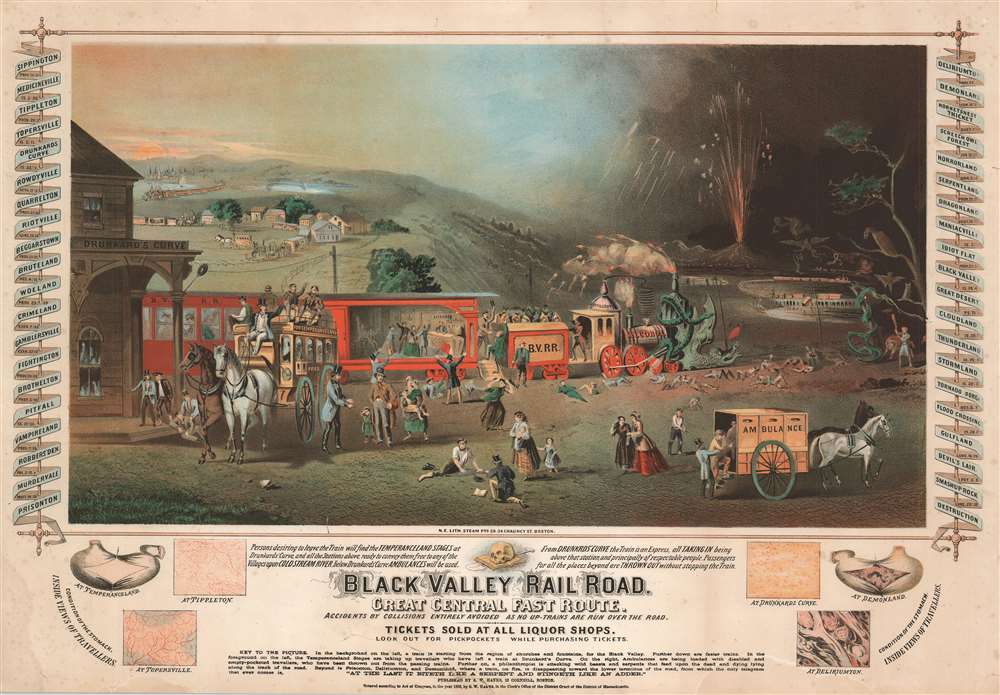This item has been sold, but you can get on the Waitlist to be notified if another example becomes available, or purchase a digital scan.
1863 Hanks Chromolithograph Temperance Broadside - Black Valley Railroad
BlackValleyRailRoad-hanks-1863
Title
1863 (dated) 15.5 x 22.5 in (39.37 x 57.15 cm)
Description
The Black Valley Allegory
The image presents an allegory of life centered on a train voyage from 'Temperance Land' a 'region of churches and fountains' to the 'Black Valley,' a dark place with volcanoes reminiscent of hell. Temperance Land appears in the background to the left, while Black Valley features prominently at the right. Surrounding the image, the various stops, between 'Sippington' and the ultimate destination, 'Destruction' are noted. Each 'stop' is underscored with a Biblical reference. The centerpiece of the image is a stop Drunkard's Curve. Here the train appears central with its engine a distillery fueled by alcohol. It has a dragon nose and a serpent is coiled around the furnace, which spews evil looking arrows. Daemons drive the train while, one car back, a saloon car hosts a lively party. In the foreground, a stagecoach bound for 'Temperance Land' saves those who are lucky or smart enough to disembark, while an ambulance carries others away. The contrast between the 'old' and 'slow' Temperance Land stagecoach and the 'fast' and 'central' train, between the 'tried and true' and modern technology (at the time) should also be noted.Period Praise
This image is derived from a book published by the author Stedman Wright Hanks, that was much acclaimed by temperance advocates,Probably the most successful temperance lecture in the country is the picture of the Black Valley Railroad. Not a few young men who have been coquetting with the intoxicating cup have shuddered and drawn back as they looked upon this representation of the drunkard’s course. . . If a copy of it had a place in every household, it would do much to keep young men from the first step in the drunkard’s career. ('Free Press'. Northampton, MA, page 219)Hanks appears to have licensed or simply given his image away, as there are several variations issued by different printers.
Chromolithography
Chromolithography is a color lithographic technique developed in the mid-19th century. The process involved using multiple lithographic stones, one for each color, to yield a rich composite effect. Oftentimes, the process would start with a black basecoat upon which subsequent colors were layered. Some chromolithographs used 30 or more separate lithographic stones to achieve the desired effect. Chromolithograph color could also be effectively blended for even more dramatic effects. The process became extremely popular in the late 19th and early 20th centuries, when it emerged as the dominate method of color printing. The vivid color chromolithography produced made it exceptionally effective for advertising and propaganda imagery.Publication History and Census
The 'Black Valley Railroad' theme was used extensively in 19th century temperance propaganda. Most can be traced to the Temperance Alliance and Stedman Wright Hanks, who developed the 'Black Valley' allegory. While we have not been able trace another exact example of this broadside, we have identified others that employ similar imagery, including one in the collections of Princeton University. The present view was issued by New England Steam Printing, based at 34 Chauncy Street, Boston. We are aware of no other examples.Cartographer
Stedman Wright Hanks (September 11, 1811 - August 23, 1889) was an American author, artist, and temperance advocate active in the middle part of the 19th century. Hanks was bornin Mansfiled, Tolland County, Connecticut. He studied at Amherst, graduating in 1837, when he became a minister of the Congregational (Trinitarian) denomination. He lived for a time in Lowell and in Cambridge, Massachusetts. An ardent tea-totaler, he was a founding member of the Temperance Alliance and the American Seamen's Friend Society, both organizations built on Temperance ideology. Hanks was also notable for his uncanny resemblance to Abraham Lincoln, to whom he was related on Lincoln's mother, Nancy Hanks', side. More by this mapmaker...

